Hurts So Good
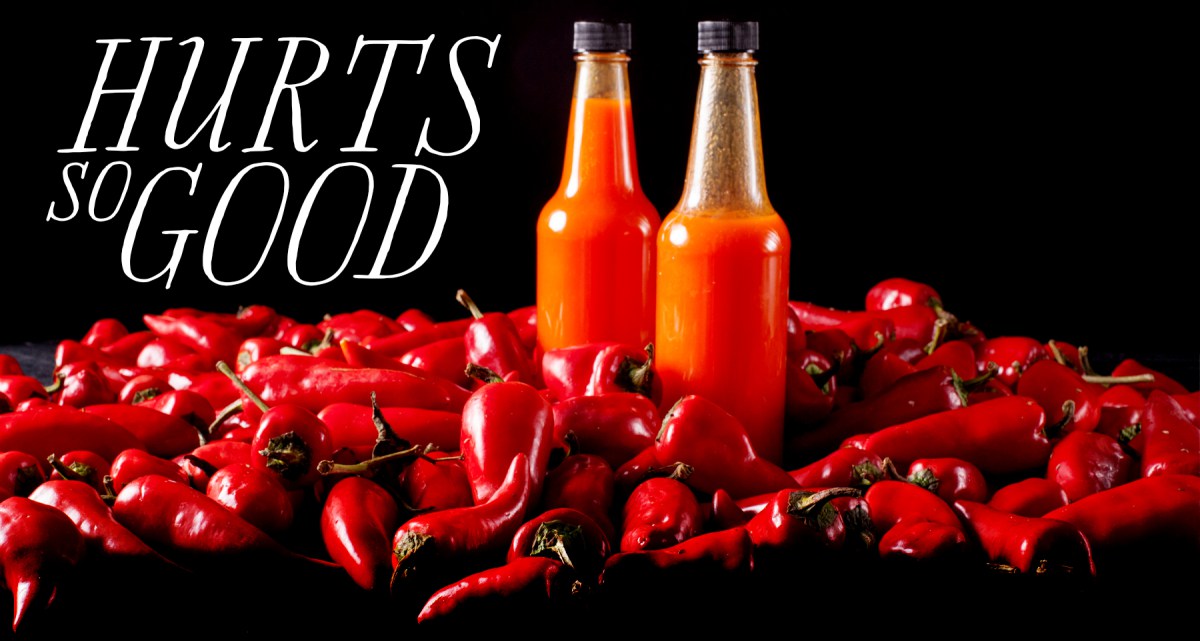
01
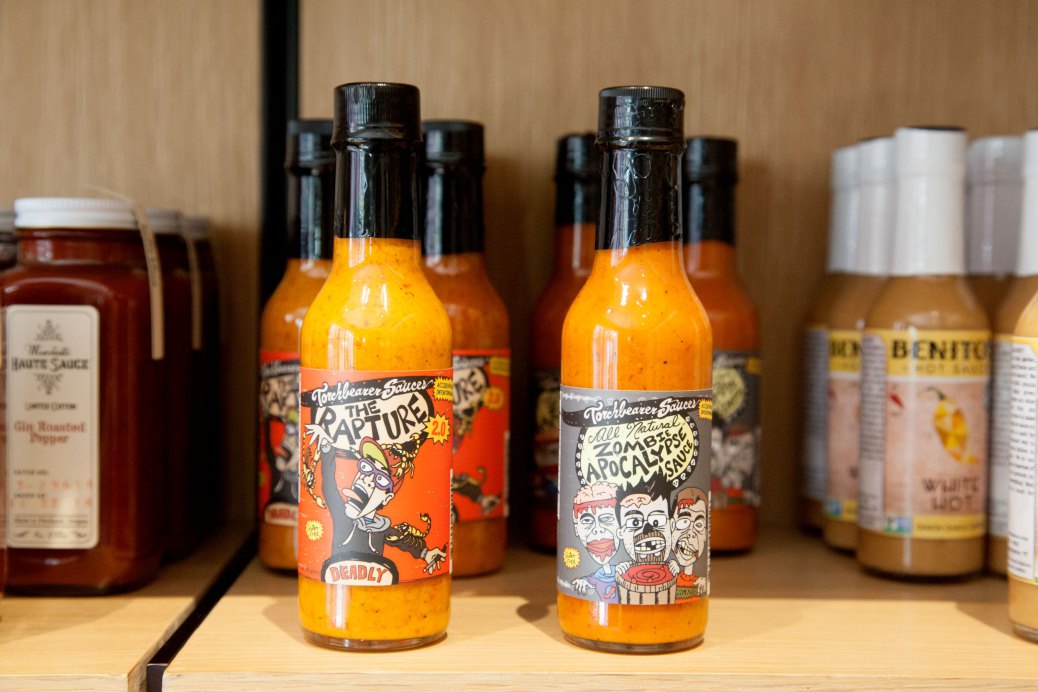
What’s the Hottest You Have?
On a sunny afternoon inside the Heatonist, a Brooklyn storefront that sells dozens and dozens of varieties of hot sauce—and nothing else—a customer avidly peruses the bottles on the shelves. “OK, but where do you keep the actually hot ones?” he asks, half joking.
This is what the great majority of his customers want, proprietor Noah Chaimberg told me earlier: “the hottest sauce you have.”
I follow the customer over to the tasting bar, where 20 bottles with dropper tops are on display. They have names like Bravado Crimson, Tears of the Sun, and Million++, the last of which refers to the strength on the Scoville heat scale of the chile peppers it’s made from.
Chaimberg uses the dropper to give us each a tiny dose of Million++ on a disposable paper spoon. The burning spreads slowly but inexorably from the tip of my tongue throughout my mouth and down my esophagus, permeating my face and scalp, which bead with sweat.
Before the heat has reached its peak, I’m already scanning the bottles to see which sauce I will try next.
02
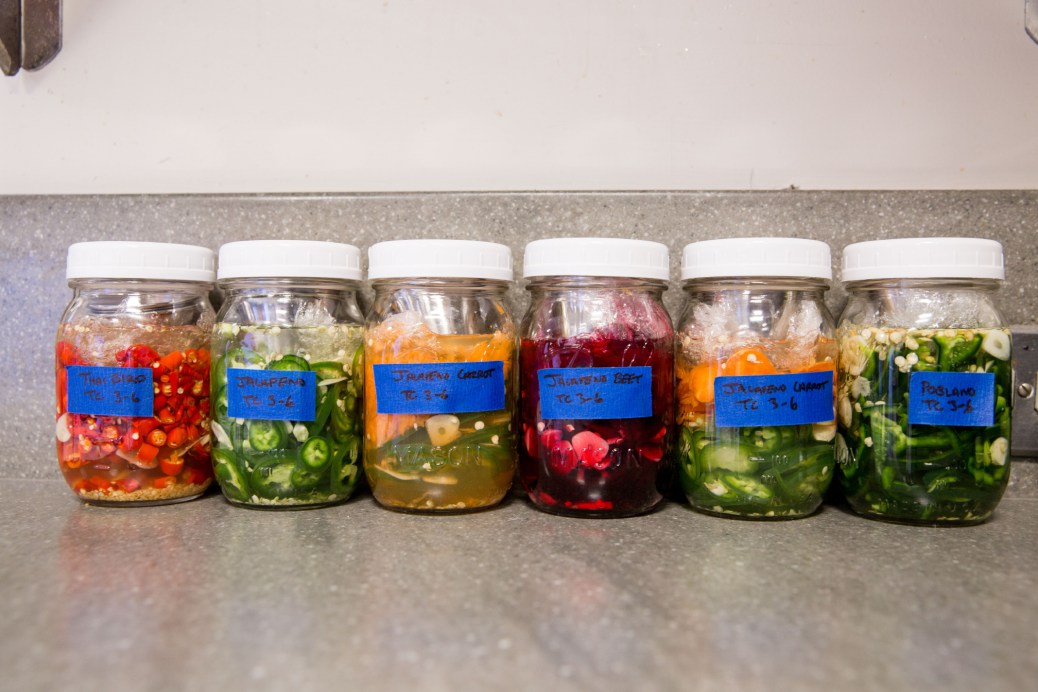
This Bud’s for You
When a piece of food is in your mouth, you sense three basic types of information about it. There’s flavor, which is made up of taste and smell working together. There’s the sense of touch that tells us about a food’s texture: how chewy it is, how round, how slippery. And, just like everywhere else on our bodies, our mouths have nerves that sense injury and temperature, the chill of ice cream or the scald of coffee, carrying those signals to the brain via a particular channel called the trigeminal nerve.
That third group, the pain and temperature group, has a fascinating quirk. One specialized receptor at the endings of the nerves, called TRPV1, is triggered by excessive heat. If you should have waited before eating that first spoonful of steaming soup, TRPV1 will tell you.
But TRPV1 can be tricked by a plant. Chiles are loaded, to greater or lesser degrees, with the chemical substance capsaicin. Capsaicin also stimulates TRPV1 nerves, masquerading as heat and in essence telling the eater’s brain: There’s a painfully high temperature situation down here in the mouth! That trick is called chemesthesis: the chemical stimulation of tactile nerves.
Chemesthesis goes far beyond the desirably irritating burn of chiles. It pops up in unexpected ways, throughout food and drink, throughout history, throughout the world. I wanted to learn more.
03
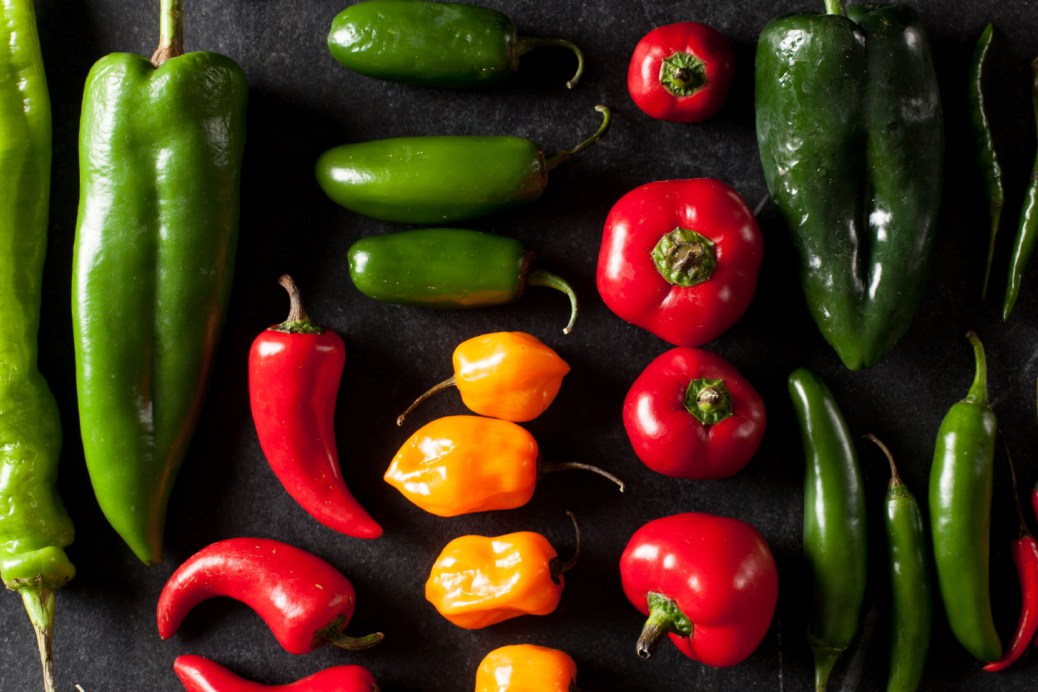
Many Types of Chile Heat
At his creative Chinese restaurant Fung Tu in New York, chef Jonathan Wu puts his spin on Sichuan má là oil, which combines the pungent effect of Sichuan peppercorns (má) and chile peppers (là). He serves the blood-red oil, which is silty with ground spices, in a dessert course, as a complement to sorbets in tart flavors like rhubarb and passion fruit. Alongside the sweet and cold sorbet, the smoky, savory spice opens a new dimension.
“Have you ever had really good Sichuan peppercorns?” Wu asked me. The ones I’ve bought many times in Chinatown or at fine spice emporia have been pretty good, I thought, with a ruddy brown color and plenty of tingle. But the ones inside the plastic quart container he showed me were the vivid maroon color of hibiscus, and the air at our table in the back of the restaurant filled with a piney, citrusy fragrance more intense than any Sichuan pepper I’ve known.
I was impressed. “It smells so fresh, so—”
“It smells like weed, doesn’t it?” Wu grinned proudly. “I tried a lot of different suppliers, but my chef’s intuition told me they could be better. Finally I found these through a friend who has connections.”
I bit into a single peppercorn, and an electric shimmer zapped the front of my tongue while a cascade of aroma permeated my nose. Wu told me how he blooms the flavor even more by dousing the peppercorns with the sizzling-hot oil that, along with a mixture of chiles, forms the base of his má là concoction. Tasting Wu’s complex má là oil, I noticed that the chile burn was very different from the commercial jarred varieties I was familiar with: slower, deeper, more persistent. I suspected that was due to the particular cultivars of chile he used.
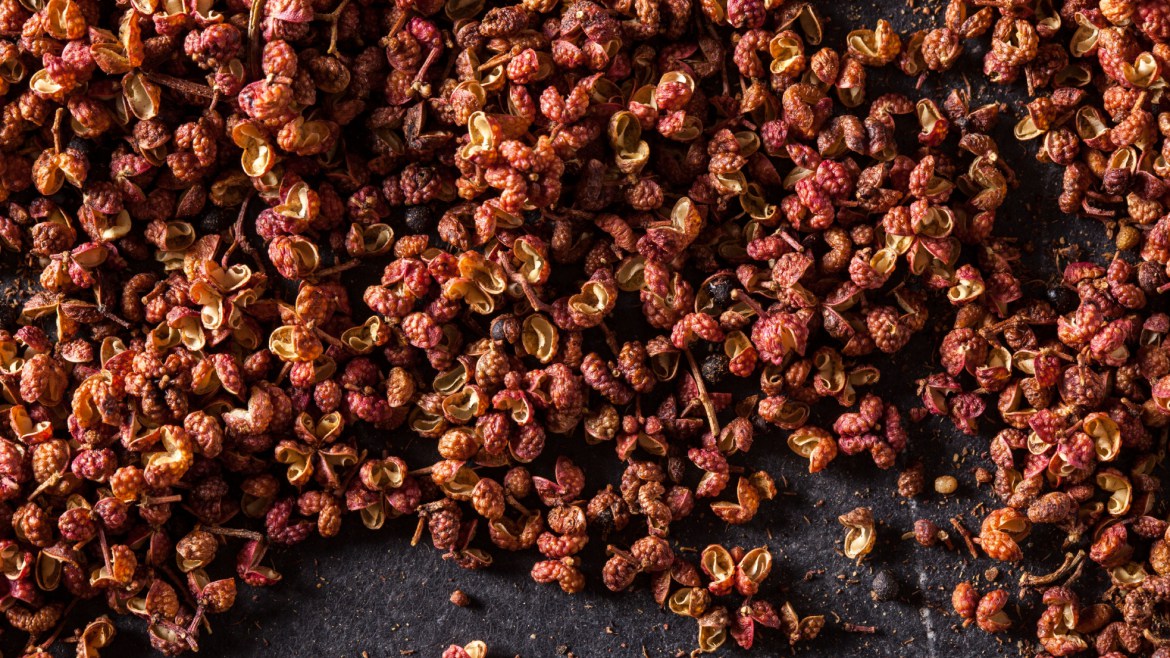
To find out more about the differences among the many breeds of chiles, I spoke to the source: the Chile Pepper Institute at New Mexico State University, where more than 150 varieties of chiles are grown, including at least 20 that were created at the university by selective breeding. (That’s a fraction of the thousands of chile varieties in existence around the world.)
Dr. Paul Bosland is the cofounder and director of the institute, which is dedicated to researching and educating the world about the potent fruit. He’s published more than 100 papers on various aspects of chiles, their growing, and their heat characteristics.
“There are at least 200 compounds contributing to the flavor of chiles,” Bosland told me. “In terms of the heat, , and they all have a different effect.” Capsaicin is the most common, first to be discovered, and hottest of the capsaicinoid family, but every chile contains a somewhat different mix of capsaicin, dihydrocapsaicin, nordihydrocapsaicin, homodihydrocapsaicin, nornordihydrocapsaicin, and quite a few others. They all fit into TRPV1 receptors in slightly different ways, and the particular mix of capsaicinoids in any given chile is responsible for the specific way we experience its heat.
To characterize the ways in which different chiles burn differently—not just the amount, but the nuances—he has developed a classification system to describe a heat profile, which rates a chile pepper on five different axes. Is the heat instant, or is there a delay before it hits? How long is the delay? Second, how long does the heat linger?
“The third one: is it sharp or flat? Is it like pins pricking you, or a paintbrush painting your tongue?” Then, where in the mouth do you feel the heat? The tip of the tongue, the midpalate, the lips, the throat? And fifth is the heat level, expressed in Scoville heat units.
Though there are exceptions, chiles from the Americas tend to burn slow and long, while Asian varieties, like the tiny bird chiles popular in Thai cooking, give a sharp, immediate, powerful heat that vanishes almost as quickly as it came.
“We were trying to export chile powder to Asia, and they said we didn’t have good quality,” says Bosland. “We didn’t know what they meant. We couldn’t figure it out. Finally we tried sending them a powder that has the sharp heat. Now they’re using millions of pounds of it.”
Bosland characterizes jalapeños’ heat as rapid onset, slow dissipation, and with a flat rather than sharp feeling. Habaneros and ghost chiles both have a flat, back-of-the-throat heat that comes on slowly and lingers painfully.
The most powerful Scoville heat yet discovered is not from a chile at all. A cactus-like mountain succulent from North Africa, the resin spurge, produces a natural chemical called resiniferatoxin (RTX), which is about 1,000 times more potent than capsaicin. Marco Tizzano, a sensory scientist at Philadelphia’s Monell Center who also trained as a cook in his native Italy, administers it to laboratory mice. One dose permanently destroys their chemesthetic sense. Undissuaded, Tizzano once tried RTX himself. “With a friend, we put one drop of a very dilute solution”—he pointed to the tip of his tongue—“and then immediately rinsed it off. At the point where we put it, I couldn’t feel anything for a week.”
Nowadays, chile heat is measured not by mouth, but by machine. A specimen of chile is dried, ground, and its capsaicin extracted with alcohol, then piped through a chromatography column that separates it into its various chemical components, allowing the capsaicinoids that are present to be precisely quantified in parts per million.
04

The Biology of Spice
Biologists believe that chile plants evolved capsaicin as a chemical deterrent, both to parasitic fungi and to mammals that would otherwise eat their fruits and either destroy the seeds by digesting them or leave them close to where they found them. Birds have TRPV1 receptors too—they can tell when a food is hot from the sun—but their temperature receptors are not triggered by capsaicin. So the plants effectively encourage birds to eat brightly colored chiles and distribute the seeds (which can survive an avian digestive tract) to new, faraway pastures in their droppings, while discouraging land animals.
But we’re not birds. Why, with such typical perversity, do we humans enjoy and seek out this chemical that’s supposed to keep us away?
Archaeological evidence shows that chiles were being eaten in central Mexico more than 7,000 years ago. And long before Wilbur Scoville created his scale, the 16th-century Spaniard Bernardino de Sahagún extensively documented the culture of the Aztecs. They bred, grew, and enjoyed dozens of varieties of chiles and ranked them on a six-tier spice hierarchy, Sahagún writes, ranging from cococ—merely hot—through cocopetzpatic and cocopetzquauitl up to cocopalatic, the hottest.
Do people who love chiles just find them less painful than the people who can’t stand them? Paul Rozin and Deborah Schiller of the University of Pennsylvania were among the first scientists to systematically study the question of why people like spicy foods. In their experiments, they found that, when given a chile sample, both groups of eaters, the chile likers and dislikers, rated it about the same average intensity. Though it tasted hotter to some people than to others, those differences didn’t line up with whether those people loved or hated it.
They also explored the hypothesis that there is a correlation between an appreciation of chile heat and what they called the masochism of everyday life: skydiving, roller-coaster riding, icy baths. Although Rozin and Schiller found limited evidence, other studies have established a definite correlation. The people who like spicy foods are often the same ones who answer true to personality-test questions like “It would be interesting to see a car accident happen.”
One day last month I drove to Philadelphia and stepped inside the Monell Center’s two adjoining buildings—distinguished by a giant sculpture in front of a disembodied golden nose and mouth. Monell is an independent research institute devoted to the study of smell, taste, and chemesthesis: the chemical senses. Over almost 50 years, its scientists have dealt with questions of nutrition, health, chemicals in the environment, occupational exposure to irritants, and a lot more. In the basement, living human taste receptor cells grow in dishes and respond to chemical stimuli, allowing scientists to gather data on thousands of taste substances in vitro.

Dr. Pamela Dalton studies the psychology of chemesthesis. When I met with her at Monell, she had recently returned from a military base where she had been helping with the development and deployment of a “malodor”—a very bad smell—as a deterrent to keep people out of restricted areas.
What is it, I asked her, about chemesthesis in particular that makes those of us who love it really love it? Why aren’t there specialty shops selling, I don’t know, salty foods, and guys who walk into them asking for the absolute saltiest thing they carry?
“Trigeminal sensation is unique. It’s a signal for danger, and there is something in that that gives us a thrill. It gives food a psychological dimension that’s missing in comfort foods.”
There are physiological differences from person to person, she says, and a food that tastes barely spicy to one may taste quite pungent to another. But the difference between people who like spicy and people who don’t “doesn’t have much to do with sensing it differently; it’s much more about differences in how we interpret the sensation.” Why the signal for danger flips to something desirable, she says, is an open question. “I don’t think we’ll ever find a single personality trait that correlates with love of spiciness. For me”—she grows her own chiles at home, for pleasure as well as business—“it’s like adding saturation to the color of something.”
05
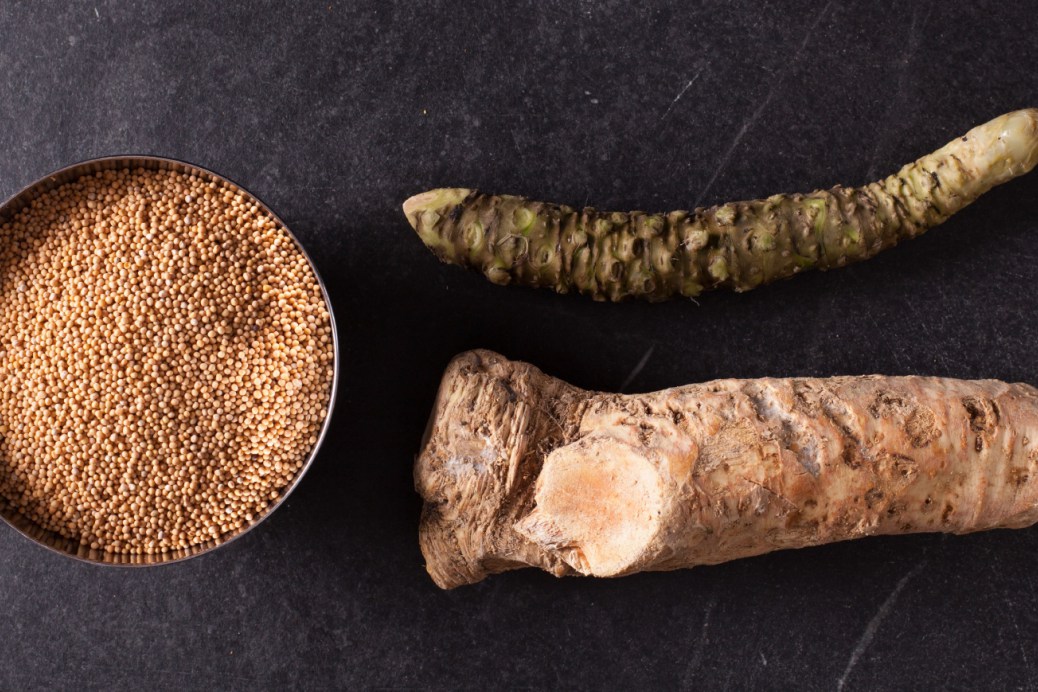
Many Flavors of Chemesthesis
I sat down in the office of Gary Beauchamp, emeritus director and president of the Monell Center, surrounded on three sides by books as well as a number of bottles of olive oil. He poured us each a neat sip of a rich straw-colored oil from California. It went down with a mild, fruity savor that blossomed into a powerful long-lived burn in the depths of my throat. I’d experienced that pungency in other high-end olive oils, where it’s considered a mark of quality, but I’d never given it much thought.
Beauchamp first identified the throat burn when he happened to be tasting local olive oils at a culinary conference in Sicily in 1999: It was identical to the sting you get when you swallow uncoated ibuprofen, which by sheer coincidence he had studied previously. He brought a particularly pungent oil home and, with colleagues, identified the irritating chemical, which they named oleocanthal. Based on the similar sensation, they hypothesized—correctly—that although it’s chemically unrelated to ibuprofen, oleocanthal has a comparable anti-inflammatory effect, and may be responsible for some of the health benefits of a diet rich in olive oil.
“Traditionally,” he told me, “peoples all over the world have identified plants that cause chemesthetic irritation as those with medicinal properties.”
I coughed.
“In the olive oil business, they talk about a one-cough oil, a two-cough oil,” said Beauchamp. “People who’ve lived their lives with it love the burn.”
I had never associated olive oil with chile peppers before, but the kinship was clear. There’s an art in deploying the right type of chemesthesis in the right way.
The uni panino at El Quinto Piño, a cozy, trim tapas bar in Manhattan, has become an iconic dish there. While richly buttered sea urchin fills your mouth with an oceanic tang, your eyes water and your sinuses start to burn. If you were thinking of wolfing the sandwich in a dozen quick bites, the pungency slows you right down, so each bite stands out.
“I thought it needed wasabi (they are such good friends),” says Alex Raij of the sandwich’s invention in 2007, “but I didn’t want the grittiness.” She laced it instead with a very pungent Korean brand of mustard-seed oil that gives the right heat in a smoother way. The same dish with chile heat instead would give it an earthbound heft, but the mustard oil feels keen and clean. How do people react to the intensity of the sandwich, I asked. “With enchantment and sensuality and libidinous delight,” Raij replied.
The active ingredient in mustard, horseradish, and wasabi is allyl isothiocyanate. It stimulates the same type of receptor as chiles do, TRPV1, but it does so in a different way, which isn’t fully understood. Those ingredients have a particular kind of chemesthesis: the sharp, eye-watering sting that you feel in your nose as the allyl isothiocyanate rises from the back of your mouth into your tender nasal chambers.
There are many other flavors of chemesthesis, each with its own biochemical mechanism, its own character, and its own fans.
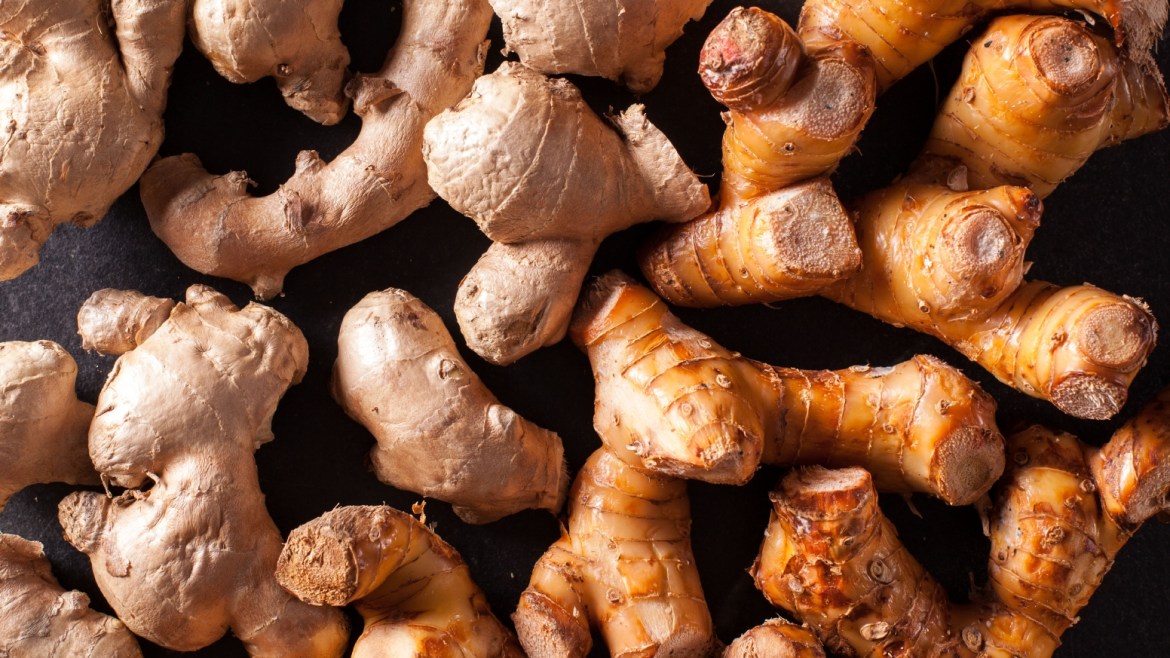
Ginger
Fresh ginger gets its kick from a compound called gingerol, and dried ginger has a stronger kick because gingerol turns into shogaol when it’s dehydrated. Gingerol and shogaol trigger our TRPV1 receptors, too, but to a lesser extent, because the shapes of the molecules mean they slot into the receptor much less snugly than capsaicin does. To pure capsaicin’s 16 million, pure gingerol scores 60,000 on the Scoville scale, and shogaol 160,000.

Black Pepper
When Christopher Columbus encountered chile peppers, he was questing for a source of black pepper, which is still the most consumed spice in the world. Black pepper contains a molecule called piperine that has a related shape to gingerol and capsaicin, and triggers TRPV1 as well, with a subjective Scoville rating around 100,000. But piperine also triggers another type of irritation receptor in the mouth, called TRPA1. That second component is why black pepper has a tingle to it as well as a burn.
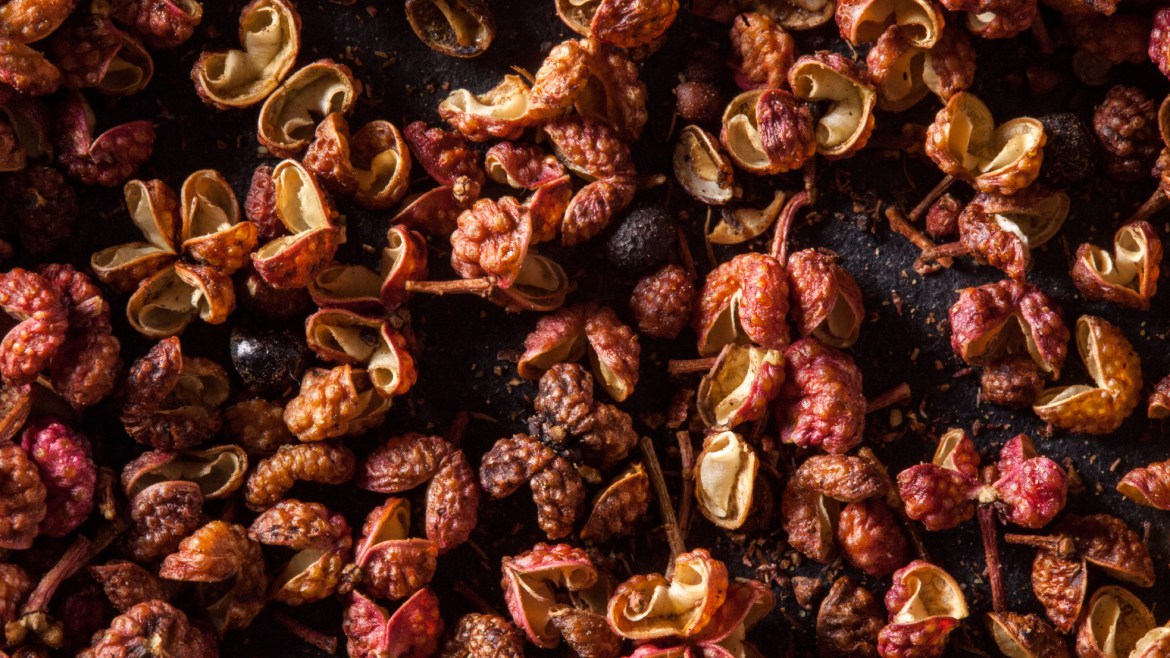
Sichuan Pepper
Outside the realm of TRPV1, the Scoville scale is not relevant, but there are plenty of other types of chemesthetic receptors in the mouth, and plenty of ingredients to stimulate them in various ways. Champion among the tinglers is the Sichuan peppercorn, which—just as black pepper and chile pepper are unrelated to each other—is no relative of either; it’s the dried husk of flesh surrounding the seed of a plant in the citrus family. Biting into one creates an unmistakable tingly prickle that seems to pulsate in rapid waves. The active chemical, alpha-hydroxysanshool (which takes its name from sansho, a Japanese member of the genus that contains the same compound), tickles an indeterminate number of different receptors at once, so it can produce, in addition to the tingle, complex sensations including simultaneous feelings of heat and coolness, numbness, and even the buzzy feeling that there’s a physical vibration in your mouth.
Mint
Just as capsaicin makes your mouth think it’s hot, the menthol in mint and related compounds in some other herbs make your mouth think it’s cold, by triggering the appropriate receptors. In the search for artificial compounds that can provide that cooling effect without a minty taste, chemists in the 1980s discovered one called icilin, which is almost 200 times cooler than menthol.
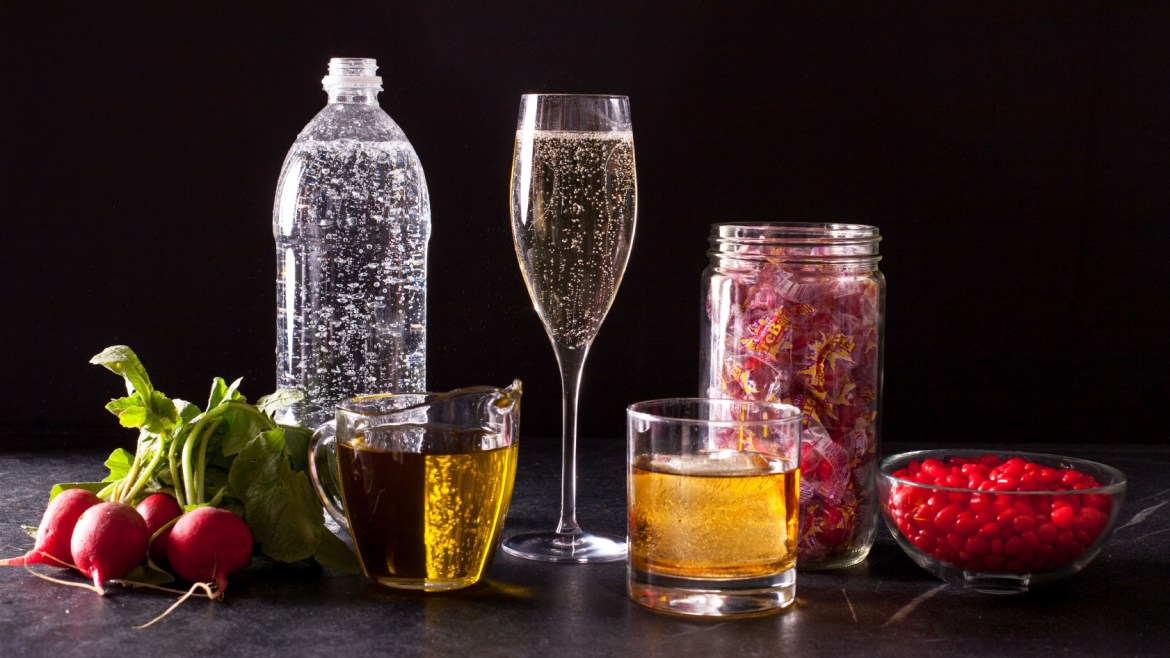
Carbonation
The pain when a cold fizzy soda hits your mouth? That’s chemesthesis too. Carbon dioxide dissolved in the soda seeps into the cells on the surface of your tongue, where enzymes convert it to carbonic acid, and carbonic acid stimulates the TRPA1 tingle receptor.
Others
The tongue burn of strong garlic. The throat burn of whiskey. The bite of a fresh radish. The numbing pungency of thyme, oregano, and cloves. The sweet fire of cinnamon that fuels Red Hots and Atomic FireBalls. Do you like any of those? Then you’re a chemesthete too. Welcome to the club.
06

Chemextremism
What about the “hotter the better” types, the people who aren’t satisfied with spice as a mere added dimension of food but who seek more and more extreme spicy experiences? What about the guys who post videos of themselves on the Internet chomping on the hottest chiles they can find and then reeling, turning red, and sometimes vomiting?
“That’s just Jackass territory, cultural machismo,” Pamela Dalton told me. “They would hit their hand with a hammer as well.”
“Why do you like it?” I asked Alex, a fellow customer in the teeming hot sauce aisle at Kalustyan’s spice shop in Manhattan. He had just recommended to me a super-powerful product whose labeling ditched the usual devils-and-flames iconography in favor of the black-on-white plain text of prescription pharmaceutical packaging, menacing in its clinical understatement.
“It’s really like a drug,” he said. “Chile heads don’t enjoy the pain, the hiccuping, the puking, but it’s a rush that comes along with it. And if you don’t have it, you start to feel something’s wrong.”
The Heatonist’s Chaimberg concurs. “It’s not totally dissimilar to running a mile. Your brain rewards you”—by releasing endorphins in response to pain—“for eating hot sauce.”
The 1980s saw a boom in hot sauces and salsa, which overtook ketchup sales in the United States in 1992. Hot sauce begat hotter sauce, and a minor arms race kicked off among sauce makers to satisfy the segment of the market for whom no amount of Tabasco was enough. The habanero, which could exceed 200,000 Scoville units, was the ultimate weapon in the chemesthetic arsenal.
“But the ’90s, that’s when the hot-hot thing started,” Chaimberg tells me. “Dave’s, Blair’s, they were the first.” Dissatisfied with the mouth-blasting capability of the habanero, competing sauce makers Dave Hirschkop and Blair Lazar turned to an ingredient that until then was known mainly as the active component in riot-control pepper sprays: capsicum oleoresin. It’s made by mixing chiles with a powerful solvent, such as ethanol or hexane, to dissolve out the capsaicin, then filtering out all the parts of the plant that aren’t capsaicin—such as the fruity, appealing flavor—and finally evaporating the solvent, leaving behind a waxy red purified residue. Ounce for ounce, the oleoresin (which is often credited as “pepper extract” on an ingredient label) is 50 or more times hotter than the habanero it’s made from. Using extract removes the nature-imposed limit to how hot a sauce can get.
The Heatonist doesn’t carry any sauces containing pepper extracts. “Some people want the hotter the better,” says Chaimberg. “Extracts are fine for that. But after you get over that, you start to realize that there can be real heat AND real flavor.”
Shortly after the habanero was listed by Guinness as the world’s hottest pepper in 1999, reports came from India of the bhut jolokia, or ghost chile, a new breed that clocked in at well over twice the habanero’s heat. When Paul Bosland obtained seeds and grew samples in New Mexico, he measured the fruit at more than 1 million Scoville units.
And Bosland found something unique about the ghost chile. Just about every other chile forms its capsaicin in specialized glands located in its internal ribs, to which the seeds are attached. The ghost chile produced capsaicin aplenty in the ribs, but also in its outer walls. The whole thing was a spice bomb.
Rahman Atta’s plant stall, in a part of the Bronx with a large North Indian and Bangladeshi population, has a colorful display of potted ghost chile plants for sale. “In Bangladesh—that’s where this pepper is from—we like it hot. If you grow chiles at home, you can put it in your food or just eat it like a fruit. My mother eats two or three every day.”
Since the appearance of the ghost chile, breeders have created several other chiles that have that hot-all-over characteristic, which tends to bump them up into the “superhot” tier of Scoville ratings that are more than 1 million. The Trinidad moruga scorpion chile weighed in at 1.2 million; then the Trinidad scorpion ‘Butch T’ variety hit 1.46 million; and the current record holder is the Carolina Reaper, which averages 1.6 million, although one specimen was measured above 2 million.
“Out of the superhots, I love the ghost,” said Chaimberg. “It’s very popular in sauces, because it has very little bitterness and a unique flavor that plays especially well with the flavors of food.” Chaimberg dripped me a sample of a sauce made with ghost chiles and Honeycrisp apples. It had an intense burn, but alongside it a complex, haunting smokiness that he assured me came straight from the chile, no smoked ingredients at all.
He handed me a paper towel from a roll at the ready behind the tasting bar, to mop some of the sweat that was now running down my face.
“It’s not the heat,” he said with a grin of recognition. “It’s what the heat makes you feel.”
07
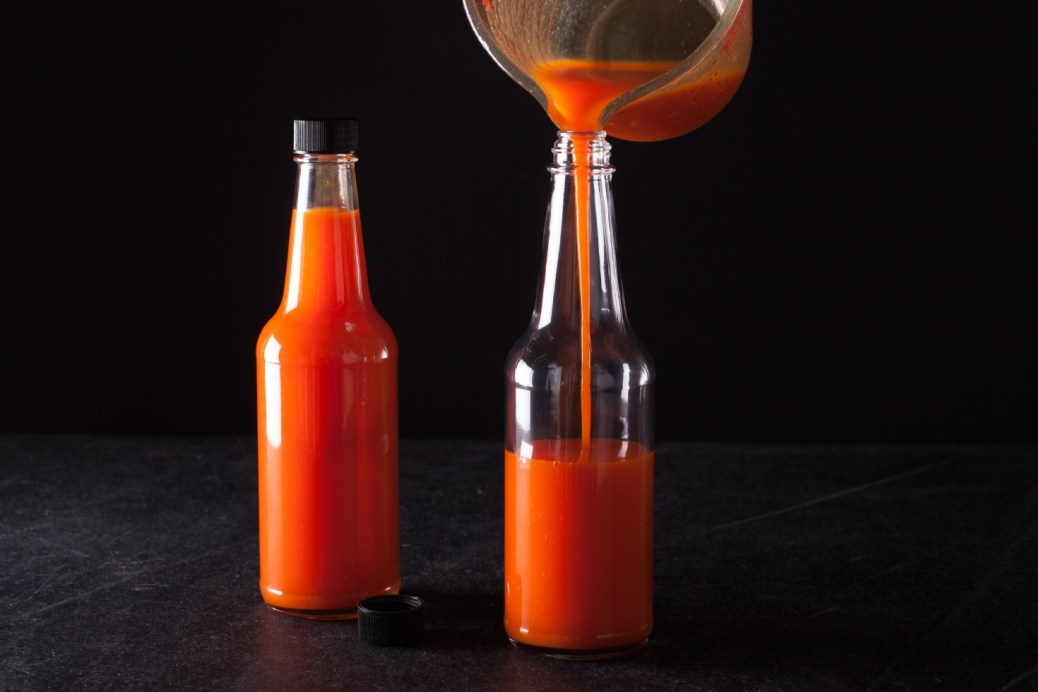
Three Questions for Paul Wise
Paul Wise, an associate member at the Monell Center, studies the complicated ways in which we perceive chemesthesis. I sat down with him over a spicy Sichuan lunch, and he gave me some practical answers to burning questions.
Cook’s Science: Do different types of chemesthesis interact, to reinforce or counteract each other?
Paul Wise: Yes. Pain counteracts itch, and both sensations can be triggered by chemical stimuli. Perhaps a more common example is that menthol cooling tends to counteract chemical irritation, including irritation from chemicals that stimulate some of the same receptors as wasabi and spicy mustard.
CS: Some people say they don’t like food that’s spicy “because they can’t taste anything else” when they eat it. What’s the basis for that?
PW: Capsaicin burn tends to mask sweetness, though results are not entirely consistent. The basis of the effect is unclear. At sufficient concentration, capsaicin tends to cause inflammation on the tongue, and some have suggested that swelling might actually pinch off taste pores, physically blocking access to taste buds. However, nicotine bite can also mask sweetness, without causing swelling on the tongue. Signals from sensory nerves on the tongue seem to interact with taste signals in the brain, and this could explain part of the effect. Of course, intense burn is distracting, so attention could play a role as well.
CS: Any recommendations for cooling off if you eat something too spicy?
PW: They say drinking water doesn’t help, but if the water’s cold it does. Capsaicin makes TRPV1 (the receptor protein for capsaicin) more sensitive to physical heat, such that this pain receptor can be activated by body heat. Cold water can temporarily push the temperature of the tongue below the threshold for the capsaicin-sensitized TRPV1 receptor. You also get pretty robust analgesia from cooling, which works by signals from cool receptors suppressing signals from pain receptors in the spinal cord or brain. So an ice cube in the mouth works very well. Ice cream is good because it has the cooling, and it may also take away some of the lipid-soluble irritants like capsaicin. Finally, just as chile burn makes sweetness less intense, sweetness also tends to make burn less intense, so ice cream could have three modes of action.
08

Back to the Test Kitchen
[Ed note: While senior editor Paul Adams reported and wrote his spicy story, associate editor Tim Chin and test cook Sasha Marx began developing spicy recipes. The following is from Tim’s perspective.]
When it comes to describing chemesthesis in food, our vocabulary is surprisingly limited. Most of us make little distinction between a dish packed with black pepper and one spiked with fresh horseradish. They are both “spicy,” maybe “hot.” And yet, the sharp nasal sting of horseradish feels very different than the tingle of black pepper. Paul’s reporting revealed how nuanced and complex the world of spicy really is. Sasha and I wanted to develop a suite of recipes that showcased a wide range of chemesthetic ingredients, from fresh chiles to Sichuan peppercorns.
During our testing we learned a lot of lessons about how to cook spicy food, but none more valuable than the importance of balance. While thrill seeking through eating superspicy food can be entertaining (and make for good YouTube viewing), it’s a practice that rarely produces great food. (Sorry to disappoint the hard-core chile heads out there hankering for more and more Scoville units.)
Think of your favorite spicy dish. Maybe it’s Texas-style chili, Thai green curry, or a pork taco drizzled with brick-red salsa. Whatever it may be, chances are good it’s a dish with a complex flavor profile. That’s not mere coincidence. There’s evidence that eating spicy food diminishes how intensely we perceive other flavors at the same time, so a spicy dish will need more (and more intense) flavors in order to taste balanced. Aromatic ingredients like cinnamon, cumin, turmeric, and cardamom; pungent garlic and scallion; wood smoke; and even chocolate work incredibly well with spice. Don’t hesitate to use a heavy hand when adding them to a spicy dish.
And don’t stop at the spice rack. This 1995 study found that capsaicin also suppresses our perception of sweetness. Cutting back on the sugar in a spicy recipe can make it taste harsh and out of balance. Sugar also has the added benefit of stimulating the pleasure centers of our brains—a handy function when the pain from capsaicin grows intolerable.
A final note on getting the spiciest bang for your buck. In 2011, executive editor Dan Souza lab-tested both water and oil infusions of red pepper flakes and found that, holding all else constant, the oil infusions averaged twice the Scoville units of the water infusions. A surefire way to infuse a dish with capsaicin heat (as well as spice flavor) is to bloom the spice first in oil or butter.
With these ideas in mind, Sasha and I headed into the kitchen and created five spicy-yet-balanced recipes to tickle (or tingle) your tastebuds.
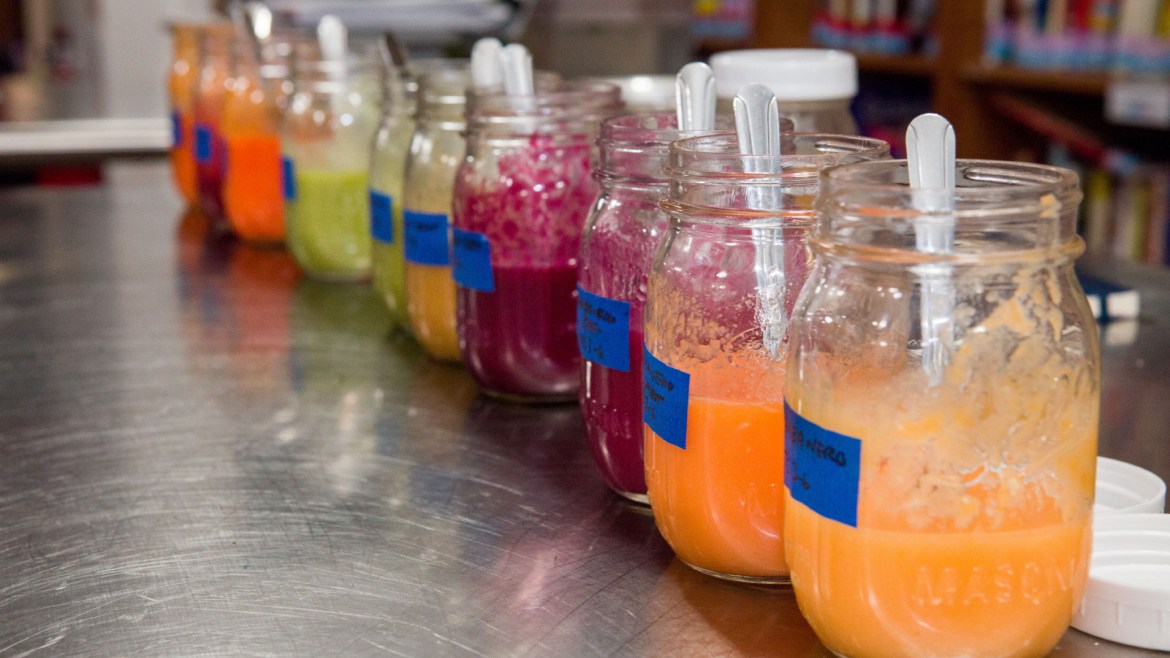
Fresno Chile-Carrot Hot Sauce
One of the fastest (and most delicious) ways to quickly add sharp heat to a dish is with a few dashes of hot sauce. I could have easily blended up habaneros, water, salt, and vinegar for a quick, pungent sauce that scored high on the Scoville scale. But the best hot sauces, the ones with great depth and complexity, rely on lactic acid fermentation. (The pepper mash for hot sauces like Tabasco and Texas Pete are actually aged in barrels for years.) Letting mine sit on the counter for a week produced funky complexity and acidity. I wanted a hot sauce with moderate capsaicin kick so that I could use it freely without the fear of blowing out my palate. In light of that, I chose Fresno chiles for their vibrant red color and tolerable heat (2,500 to 10,000 Scoville units). To bring vegetal sweetness (to balance that heat!) and color, I added some carrots. And a bit of garlic reinforced the savory qualities of the sauce. Our whole team went home with pint containers of the finished product, and according to everyone’s reports, it’s especially nice on eggs, tacos, fish, chicken, and rice.
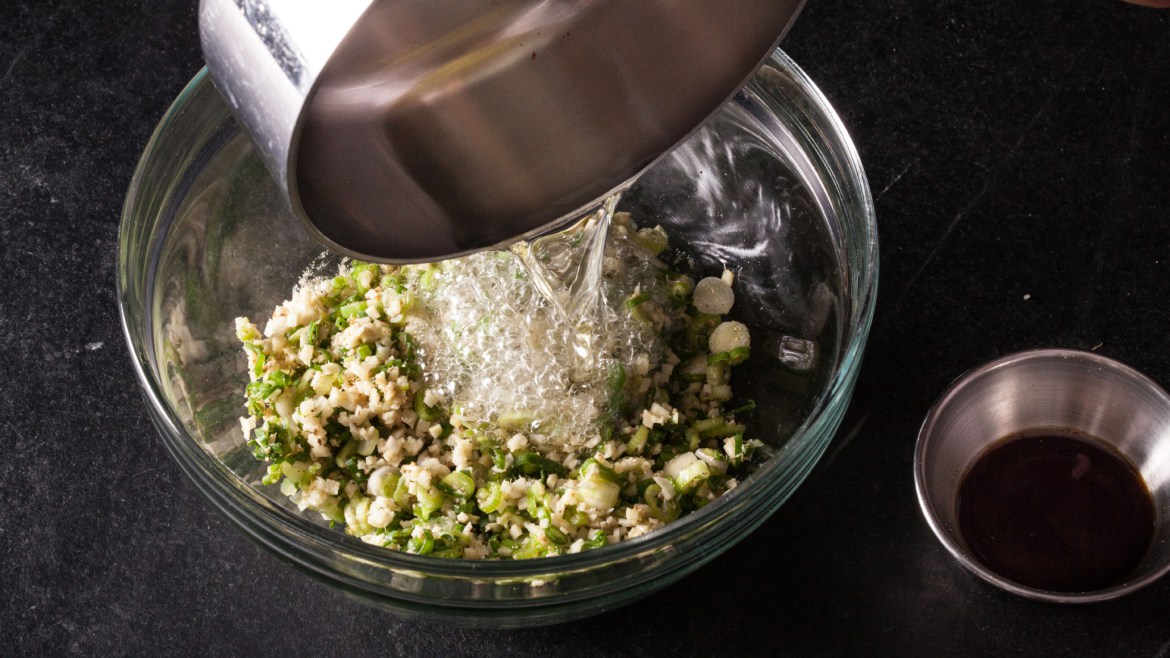
Ginger-Scallion Everything Sauce
As an exploration of chemesthesis beyond capsaicin, Sasha developed an all-purpose ginger-scallion sauce inspired by a classic Chinese condiment. Fresh ginger is high in the chemesthetic compound gingerol, which, though spicy, is far milder than the capsaicin in chiles. But when fresh ginger is dried, gingerol turns into shogaol—which is about twice as potent as gingerol. By supplementing fresh ginger with dried, this sauce maintains a lingering burn. To add complexity to that feeling, Sasha also included a small amount of white pepper (which contains the spicy compound piperine). The combination of ginger and pepper in this recipe triggers TRPV1 and TRPA1 receptors, producing both a mellow burn and a subtle tingling sensation. This complex background heat enhances the floral sweetness of fresh ginger without overpowering it. This sauce is good spooned on grilled or sautéed vegetables, noodles, meat, fish . . . as the name implies, pretty much everything.
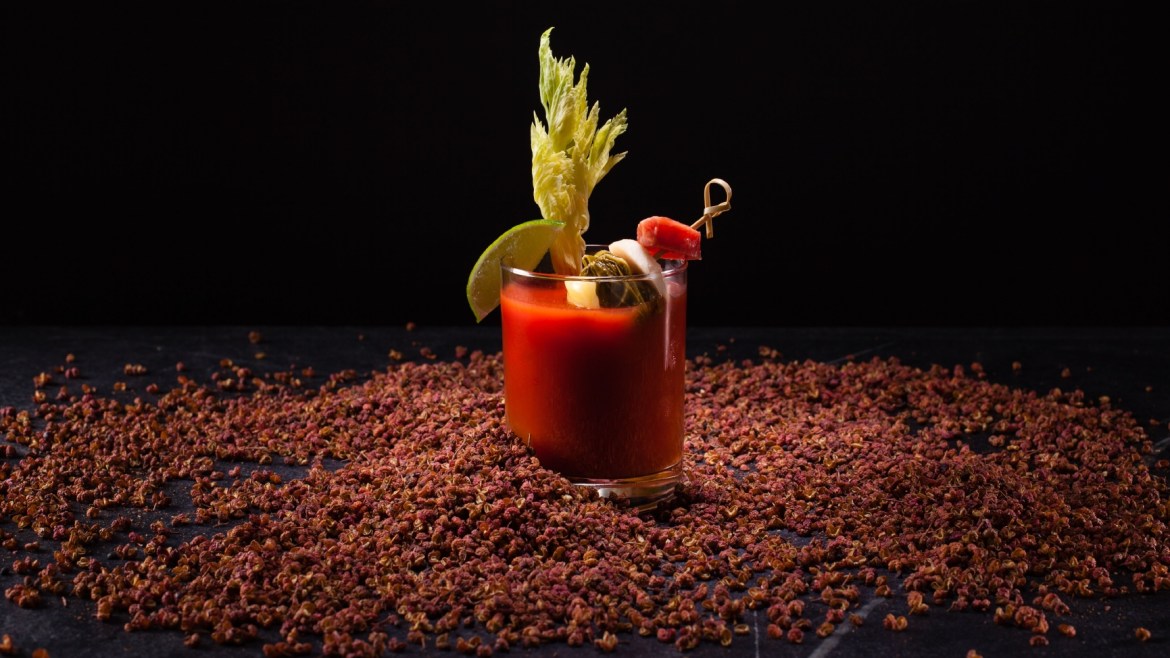
Better Bloody Marys
Going further down the chemesthesis rabbit hole—and in his never-ending quest to take brunch to the next level—Sasha turned his attention to the classic spicy brunch beverage: the Bloody Mary. For his Fresh Horseradish Bloody Mary, he replaces traditional hot sauce (rich in long-burning capsaicin) with lots of fresh grated horseradish for a sharp, eye-watering punch. (That horseradish heat comes from allyl isothiocyanate, another TRPV1 stimulator.) To reinforce the horseradish kick, this cocktail also features Chinese mustard powder, another ingredient abundant in allyl isothiocyanate. This nasal-clearing combination is grounded with lots of umami, in the forms of fish sauce and Worcestershire sauce.
For his Spicy and Numbing Sichuan Bloody Mary, Sasha employed one of the most interesting chemesthetic ingredients available: Sichuan peppercorns. Sichuan peppercorns contain alpha-hydroxysanshool, a compound that acts on receptors typically associated with touch, resulting in a tingling or buzzing sensation that is often described as numbing. Alpha-hydroxysanshool is quite soluble in alcohol, so Sasha infused it into the vodka for these cocktails. The result is a slow-building, mouth-numbing effect that complements the capsaicin burn of broad-bean chile paste. If this drink doesn’t cure what ails you on a Sunday morning, nothing will.
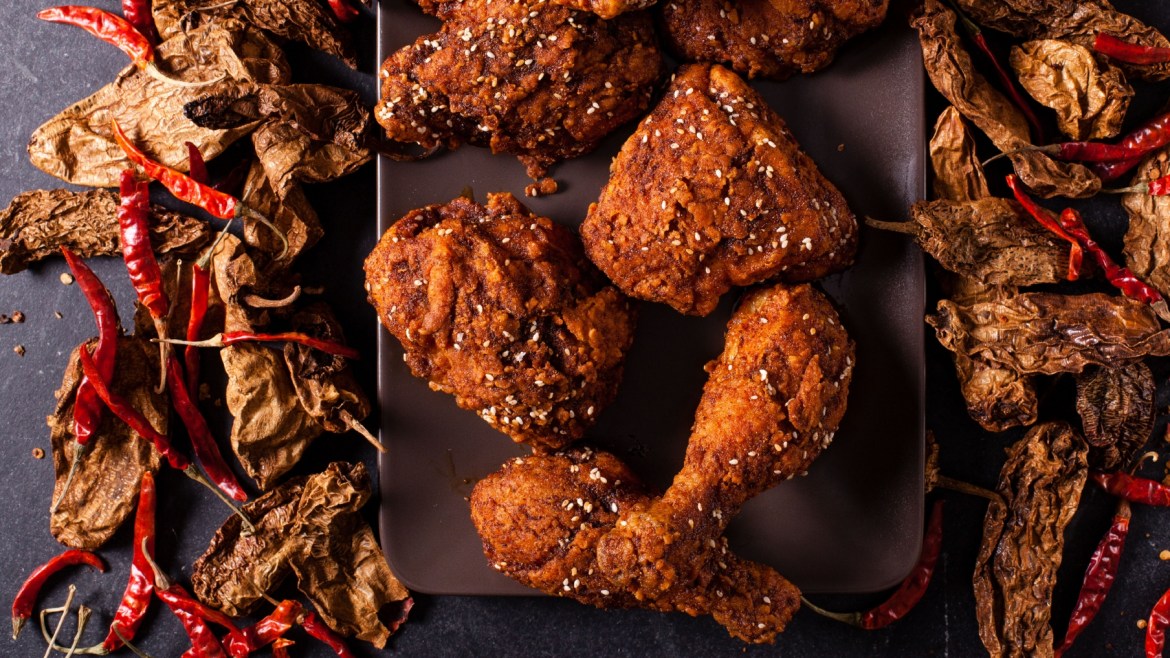
Mole Hot Fried Chicken
Rounding out our suite of spicy recipes is a version of fried chicken inspired by Nashville-style hot chicken. In the original, a generous spoonful of cayenne-infused oil or lard gets splashed over the fried chicken just before serving. It adds an intense, fiery burn that can, at times, overpower anything and everything in its way. The technique of blooming chiles in oil (and ladling it over fried chicken) is great, but again I wanted more balance. Adding some of the flavors found in Mexican moles—cinnamon (another chemesthetic ingredient containing the compound cinnamaldehyde), cocoa powder, sesame seeds, and cumin—rounded out the flavor. Add a supercrunchy crust fortified with potato starch and this is one fried chicken recipe sure to produce tears of joy.
Styled Food Photography by Kevin White.
Test Kitchen Photography by Steve Klise and Kevin White.
Food Styling by Catrine Kelty.
Art Direction by Lindsey Chandler.
